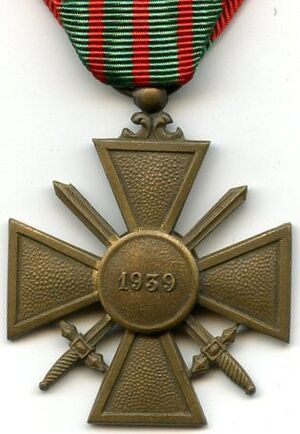Croix de Guerre 1939–1945 facts for kids
The Croix de Guerre 1939–1945 (which means "War Cross 1939–1945" in English) is a special French military award. It was created on September 26, 1939. This medal was given to people who showed bravery during World War II.
It honored those who fought with the Allied forces against the Axis powers. After Germany took over mainland France in 1940, a different version of this award was made. However, the original Croix de Guerre was still used by Free France. Today, only the original version is officially recognized by the French government.
Contents
What is the Croix de Guerre?
This award recognized military service during World War II. It was given to soldiers, sailors, and airmen. People who fought in many different areas could receive it. This included battles in France, North Africa, and the Middle East. It also honored members of the French Forces of the Interior and Free French Forces.
How the Medal Looks
The Medal Design
The Croix de Guerre was designed by a sculptor named Paul-Albert Bartholomé. The medal is about 37 millimeters (1.46 inches) wide. It is shaped like a Maltese cross. Two swords cross behind the center of the medal.
In the middle of the front side, you can see the profile of the French Republic. This image wears a special hat called a Phrygian cap. Around this portrait, the words République française ("French Republic") are written. On the back of the medal, you will find the dates of the conflict. These dates are either 1939–1940, 1939–1945, or simply 1940.
The Ribbon
The ribbon that holds the medal is red. It has four green lines running through its center. This ribbon is worn on a uniform.
Ribbon Devices and What They Mean
Every medal and ribbon has at least one small device attached to it. These devices are shaped like a palm or a star. They can be made from bronze, silver, or silver-gilt (which is like gold-plated silver). These devices show how important the bravery was. The more devices a person has, the more times they were recognized for their courage. There is no limit to how many devices can be on a Croix de Guerre.
Award Levels
The different devices on the ribbon show different levels of recognition. This is called being "Mentioned in Despatches." It means a soldier's brave actions were officially noted in military reports.
 A Bronze star (étoile en bronze) means the person was recognized at the regiment or brigade level.
A Bronze star (étoile en bronze) means the person was recognized at the regiment or brigade level. A Silver star (étoile en argent) means the person was recognized at the division level.
A Silver star (étoile en argent) means the person was recognized at the division level. A Silver-gilt star (étoile en vermeil) means the person was recognized at the corps level.
A Silver-gilt star (étoile en vermeil) means the person was recognized at the corps level. A Bronze palm (palme en bronze) means the person was recognized at the army level.
A Bronze palm (palme en bronze) means the person was recognized at the army level. A Silver palm (palme en argent) is special. It means the person earned five bronze palms.
A Silver palm (palme en argent) is special. It means the person earned five bronze palms. A Silver-gilt palm (palme en vermeil) was given for recognition at the Free French Forces level during World War II.
A Silver-gilt palm (palme en vermeil) was given for recognition at the Free French Forces level during World War II.
These awards are similar to the Bronze Star and Silver Star in the United States. They are also like the Military Cross and Military Medal in the United Kingdom.
The Vichy France Version
After Germany occupied France in May 1940, a different French government was formed. This was the Vichy French government. They created their own versions of the Croix de Guerre. These medals had a black and green ribbon instead of the original red and green.
The Free French government and the French government after the war did not recognize these Vichy awards. It is now against the law to wear them in France. The Vichy Croix de Guerre also had different levels of recognition, similar to the official one.
| Ribbon | Awards |
| Croix de guerre (from Vichy France; for World War II service) | |
| Croix de guerre of the French Volunteers Legion (for Eastern Front World War II service) |
Famous People Who Received It (Non-French)
Many brave people from other countries also received the Croix de Guerre. Here are some of them:
- Omar Bradley
- Joseph Collins
- Douglas Fairbanks, Jr.
- Virginia Hall
- Courtney Hodges
- Samuel M. Hogan
- Lyman Lemnitzer
- Douglas MacArthur
- Robert Mellard
- Draža Mihajlović
- Malcolm Muggeridge
- Audie Murphy
- George S. Patton, Jr.
- Prince Philip, Duke of Edinburgh
- Rainier III, Prince of Monaco
- Matthew Ridgway
- James Stewart
- Maxwell Taylor
- Strom Thurmond
- John William Vessey, Jr.
- Paul F. Warburg
- William Westmoreland
- Earle Wheeler
- Richard Winters
- Joseph Wolhandler
- Tommy Yeo-Thomas
See also
 In Spanish: Croix de guerre 1939-1945 para niños
In Spanish: Croix de guerre 1939-1945 para niños
- Ribbons of the French military and civil awards
- Croix de guerre 1914–1918
- Croix de Guerre (Belgium)




